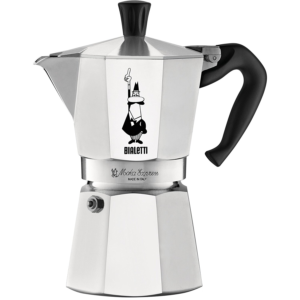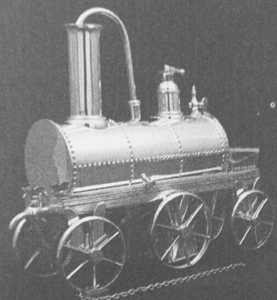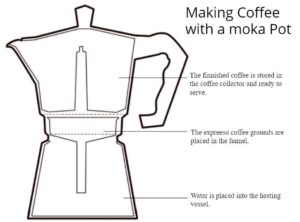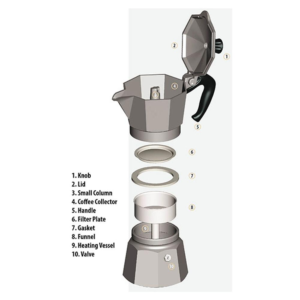Technical Description of the Bialetti Moka Express Pot
City College of New York
AuthorNote:
This paper was written for English 21007 taught by Professor Susan Delamare. Correspondence concerning this paper should be addressed to
Contact: [email protected]
Table of Contents
Abstract p. 3
Introduction p 4
Background p. 5
List of Parts & Function p. 9
Conclusion p. I3
List of Figures p. 14
Reference p. 15
Abstract
This Technical Description examines the Bialetti Moka Pot, its main components and their functions. It also explores the historical context of its invention and its consequences on Italian Society and the world.
Introduction
The Bialetti Moka Express or Moka Pot, is a simple stove top coffee maker that uses espresso coffee grounds to makes an espresso like coffee in the comfort of your home. The moka pot was invented in 1933 by Luigi di Ponti, and the patent sold to Alfonso Bialetti who took the design and mass produced it (Clayton, 2018). This revolutionized coffee culture in Italy and subsequently spread around the world. At a time when Italian, espresso coffee was only prepared and consumed in coffee shops, the Bialetti moka pot allowed Italians a way to prepare espresso like coffee at home at an affordable price.

Background
In order to understand the significance and the design of the Bialetti Moka pot, its is essential to examine the the historical context of the moka pot’s creation and its predecessor, the espresso machine. In the beginning, the consumption of coffee was mostly done publicly by men in coffee shops. At the time, drinking coffee was considered masculine, and coffee shops were akin to social clubs for Italian men, where they would drink coffee, spread ideas, and socialize (Joshua, 2016). At the turn of the 20th century, Italians began to idealize speed, efficiency, power, and machinery. Caffeine because of its energetic properties, became a symbol of modernity and subsequently the coffee shops (Joshua, 2016). This pursuit of modernity, induced the mechanization of coffee makers, that could create a strong brew with a high concentration of caffeine. These forces culminated in the creation of the steam powered espresso machines. The espresso machines were heavy, high maintenance, expensive and were only available at coffee shop (Joshua, 2016). The coffee that was produced was strong flavor that Italians loved. Compared to espresso home brewed coffee was weak and boring, so Italian men continued to mostly only drink coffee outside. For the time being, espresso would be mostly a social beverage only enjoyed at coffee shops. Figure 2 below shows the size and complexity of these espresso machines of the early 20th century.

In 1933 Luigi di Ponti invented the moka pot and sold the patent to Alfonso Bialetti who took the design and mass produced it (Clayton, 2018). The Bialetti Moka Express was a stovetop coffee maker that created espresso like coffee at home with the benefit of being a fraction of the cost, and low maintenance. It’s design was based off Italian coffee services of the upper class of the time and made of aluminum which was revolutionary at the time (Clayton, 2018). While the pot was being designed, Italy was going through major changes. With the
beginning of industrialization under Mussolini’s fascist regime, stainless steel became scarce and made the abundant Aluminum, Italy’s national metal (Joshua, 2016). This nationalistic push of aluminum facilitated the acceptance of Bialetti’s Moka Express in Italy.. The Moka Express allowed espresso like coffee to be consumed at home. The Moka express was a success and Italian men began to drink coffee at home. This caused a major shift in Italian coffee culture(Joshua, 2016). Now strong espresso like coffee could be consumed at home and was not only available at coffee shops. Eventually 90% of Italians families would have a moka pot (Joshua, 2016). Eventually, the moka pot would spread to other parts of Europe, Latin America and the rest of the world.
The design itself is both practical and visually appealing. It was inspired by Italian Coffee Service of the upper classes of the time , and was one of the first kitchen appliances in Italy that used food grade aluminum (Clayton, 2018). It has an octogonal shape with a plastic handle and knob. It is famous for its little man with a moustache illustration on its side. Its design is so highly regarded , you can find the moka express at the the Cooper-Hewitt and the National Design Museum (Clayton, 2018). The design is also functional and easy to use. As shown in figure 3 on the next page, there are three main parts on the moka pot used when preparing coffee.

Moka Express Parts and Description
The Moka Express consists of 10 main parts as shown in the figure below. A further analysis of the parts will be explained after figure 4 (Note I will be describing the 3 cup Moka Express).

- Knob
The knob is made of plastic and is screwed to the middle of the lid.. It has a truncated cone shape with a flat top and 6 elliptical groves on its side. Its shape and groove allow for better grip, while the plastic provides insulation. The insulation for the knob allows the lid to open and close while the pot is hot.
- Lid
The lid is made from food grade aluminum (Moka Express. n.d.). It’s top is screwed to the knob in the middle and attached by a pin to the handle on its back. It has an octagonal umbrella like shape with the front side having a triangle shape attached. The lid is used to open or close the coffee collector. It also prevents the coffee from spilling when it spurst out of the small column.
- Small column
The small column is made of aluminum and is attached to the coffee collector (Moka Express. n.d.). It has a truncated cone shape with the base attached to the coffee collector and the top has two horizontal slits. The coffee is pressured up the truncated cone and then spurts out into the coffee collector. The small column producing a spurting sound announcing that the coffee is ready..
- Coffee Collector
The Coffee collector is a hollow vessel made of food grade aluminum and could hold 3 cups of coffee (Moka Express. n.d.). The bottom is attached to the small column while the back is attached to the handle. It has an octagonal tapered shape which decreases its radius from top to bottom . The top front has a triangular spout where coffee is poured out of. The bottom side is cylindrical with thread on its inner sides which allows it to attach to the heating vessel. The coffee collector is where the finished coffee is stored and poured out of.
- Handle
The handle is made of black plastic .(Moka Express. n.d.) It is attached to the lid and coffee collector. It has roughly the shape of the number seven. The plastic insulates the handle allowing the moka express to be moved.
- Filter plate
The filter plate is attached to the bottom of the coffee collector. It has a cylindrical shape on the bottom while the top sides are flat and extend out forming a ring shape. It has a 2 and a half inch diameter, porous and made of aluminum (Moka Express. n.d.). The filter allows the coffee to rise up the small column into the collector while filtering out the coffee grind.
- Gasket
The gasket is made of rubber has a ring shape and has an outside diameter of 2 and a half inches (Moka Express. n.d.). The gasket seals the filter plate and prevents leakage.
- Funnel
The funnel is made of aluminum (Moka Express. n.d.). It has a cylinder shape on the top with a porous base that has a narrow cylinder extension.. It is placed between the heating vessel and coffee collector. The funnel is where the coffee grinds are placed while preparing coffee.
- Heating vessel
The heating vessel is made of food grade aluminum (Moka Express. n.d.). It has an octagon shape that tapers up. The vessel is hollow and has treads on the side of the circular top. The water used for the coffee is placed into the vessel. The heating vessel is screwed to the coffee collector with the funnel, gasket, filter plate in between. The Heating vessel is the bottom of the moka pot and is place directly onto the flame with water while preparing the expresso.
- Valve
The valve is located on the flat side of the heating vessel. It has a hexagon outer shape with a dome shape in the middle. It has a bronze like color. The valve is a safety valve that prevents the heating vessel from accumulating too much pressure and exploding.
Conclusion
The Bialetti Moka Pot revolutionized consumption of espresso like coffee. It democratized the consumption of espresso like coffee and even shifted coffee culture in Italy and the rest of the world. Espresso like coffee could be consumed in the comfort of your own home, without a huge cost or inconvenience compared to more pricey and heavy espresso machines. With the combination of its practicality and design, the Bialetti Moka Express is still used even in present times more than 70 years after it was invented. I know for a fact that it makes great strong coffee because I have one in my house and use it daily.
List of Figures
Figure 1 Bialetti Moka Express
Figure 2 Old Espresso machine
Figure 3 Making Coffee with Moka Pot
Figure 4 Moka Express Parts
References
Joshua, M. (2018, April 23). The Story of the Bialetti Moka Express.
Retrieved from https://ineedcoffee.com/the-story-of-the-bialetti-moka-express/
Clayton, L. (2018, August 09). Coffee Maker History: The Moka Pot.
Retrieved from https://drinks.seriouseats.com/2014/02/moka-pot-history-coffee-maker-italian-caffetiera.html
Moka Express. (n.d.).
Retrieved from http://www.bialetti.com/coffee/stovetop/moka-express-c-1_7_22.html?zenid=tact5t8irih1us4p7l29ajrf07.
Description in Bialetti (n.d.). [Figure]
Retrieved from http://www.bialetti.com/coffee/stovetop/moka-express-c-1_7_22.html?zenid=tact5t8irih1us4p7l29ajrf07.
Moka Express in Amazon n.d., [Figure}
Retrieved from https://images-na.ssl-images-amazon.com/images/I/61UnBgjFTEL._SY606_.jpg
Joshua, M. (2018, April 23). The Story of the Bialetti Moka Express. [Figure]
Retrieved from https://ineedcoffee.com/the-story-of-the-bialetti-moka-express/
Moka Pot in Wikiwand, n.d., [Figure]
Retrieved from http://upload.wikimedia.org/wikipedia/commons/thumb/d/da/MokaCoffeePot.svg/340pxMokaCoffeePot.svg.png


